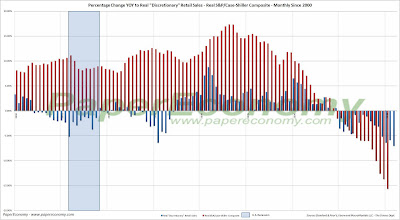 Today, the U.S. Census Bureau released its latest nominal read on retail sales showing a increase of 0.2% from February 2008 and 2.0% since March 2007 on an aggregate of all items including food, fuel and healthcare services.
Today, the U.S. Census Bureau released its latest nominal read on retail sales showing a increase of 0.2% from February 2008 and 2.0% since March 2007 on an aggregate of all items including food, fuel and healthcare services.Discretionary retail sales including home furnishings, home garden and building materials, consumer electronics and department store sales, on the other hand, experienced a significant decline falling 0.58% since February 2008 and 3.66% compared to March 2007.
Further, adjusted for inflation, discretionary retail sales declined 0.61% since February 2008 and 7.05% since March 2007.
 On a “nominal” basis, there appeared to be “rough correlation” between strong home value appreciation and strong retail spending preceding the housing bust and an even stronger correlation when home values started to decline.
On a “nominal” basis, there appeared to be “rough correlation” between strong home value appreciation and strong retail spending preceding the housing bust and an even stronger correlation when home values started to decline.The following charts show the initial analysis plotting the year-over-year change to an aggregate series consisting of the primary discretionary retail sales categories that I termed the “discretionary” retail sales series and the year-over-year change to the S&P/Case-Shiller Composite home price index since 1993 and since 2000.

 As you can see there was, at the very least, a coincidental change to home values and consumer spending during the boom and then the bust, but as home values have continued to decline, retail spending has remained low but has not continued to consistently contract.
As you can see there was, at the very least, a coincidental change to home values and consumer spending during the boom and then the bust, but as home values have continued to decline, retail spending has remained low but has not continued to consistently contract.One problem with this initial analysis is that both retail sales and the S&P/Case-Shiller Composite index are reported in “nominal” (i.e. non-inflation adjusted) terms and thus result in a somewhat skewed view especially for the retail sales data.
In fact, the year-over-year change to “nominal” discretionary retail sales has been positive for seven of the last eight months while the year-over-year change to “real” discretionary retail sales has been negative for twelve straight months (see the following chart).
 The key point here is that although inflation (as reported by the CPI) has been relatively stable in recent years it is always a factor and in light of the latest surprise increases to the CPI results as well as many anecdotal reports of producers now passing through increasing energy prices to the consumer, it’s important to adjust retail sales (and home values) in order to fully understand its direction.
The key point here is that although inflation (as reported by the CPI) has been relatively stable in recent years it is always a factor and in light of the latest surprise increases to the CPI results as well as many anecdotal reports of producers now passing through increasing energy prices to the consumer, it’s important to adjust retail sales (and home values) in order to fully understand its direction.
 As you can see from the above charts (click for larger version), adjusted for inflation (CPI for retail sales, CPI less shelter for S&P/Case-Shiller Composite) the “rough correlation” between the year-over-year change to the “discretionary” retail sales series and the year-over-year S&P/Case-Shiller Composite series seems now even more significant.
As you can see from the above charts (click for larger version), adjusted for inflation (CPI for retail sales, CPI less shelter for S&P/Case-Shiller Composite) the “rough correlation” between the year-over-year change to the “discretionary” retail sales series and the year-over-year S&P/Case-Shiller Composite series seems now even more significant.Given the anecdotal accounts of homeowners drawing equity out of their homes with refi’s and HELOCs and using the proceeds to buy consumer goods, it could be interesting to attempt to “shift” the retail spending in time as the decline to home values would surely precede a pullback in consumer spending but for now I’ll leave it aligned and work on the shifting in a later post.
In past posts I attempted to build a 12 month moving Pearson’s correlation series in order to demonstrate the true correlation between the rate of change of both discretionary retail sales and home values but although the movements may be coincidental, they really share no actual binding correlation.
I may dust off the correlation chart in future posts but for now let’s just assume that both home values and discretionary retail sales are not doing very well, especially in “real” terms and the correlation is at least coincidental with the overall unhealthy state of the economy.